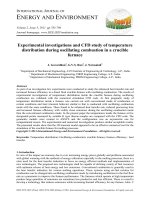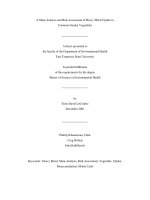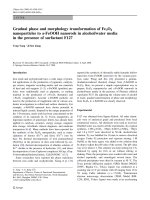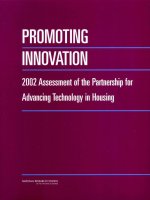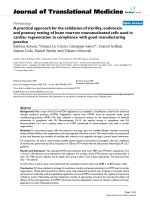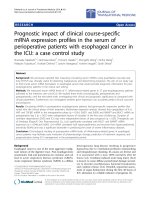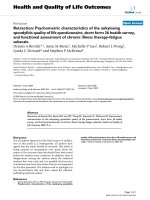Microbiological and physicochemical assessment of soil contaminated with dye effluent in Sokoto state, Nigeria
Bạn đang xem bản rút gọn của tài liệu. Xem và tải ngay bản đầy đủ của tài liệu tại đây (255.19 KB, 8 trang )
Int.J.Curr.Microbiol.App.Sci (2018) 7(6): 3800-3807
International Journal of Current Microbiology and Applied Sciences
ISSN: 2319-7706 Volume 7 Number 06 (2018)
Journal homepage:
Original Research Article
/>
Microbiological and Physicochemical Assessment of Soil Contaminated with
Dye Effluent in Sokoto State, Nigeria
Nafi’u Abdulkadir1*, Hauwa B. Abubakar1, M. H. Usman1, A. Sanusi5, G. Mustapha1,
M. Sirajo2, B. Muhammad3, Safina A. Yerima4 and Bashar B. Ladan1
1
Microbiology Department Sokoto State University, Along Birnin Kebbi Road
Sokoto State Nigeria
2
Department of Chemistry Sokoto State University, Along Birnin Kebbi Road
Sokoto State Nigeria
3
Department of Microbiology Bayero University Kano, Kano State Nigeria
4
Department of Biology Shehu Shagari College of Education, Sokoto Nigeria
5
Department of Biological Science University of Science and Technology Aleiro,
Kebbi State Nigeria
*Corresponding author
ABSTRACT
Keywords
Physico-chemical,
Microbiological, Soil,
Synthetic dye, Effluent
discharge, bacteria viable
count
Article Info
Accepted:
25 May 2018
Available Online:
10 June 2018
The study was aimed to investigate the quality of soil polluted with dye effluents in
Sokoto. Soil samples were collected from different dying centers in Sokoto in order to
determine microbiological and physicochemical changes of soil using standard procedures.
The results revealed the average count of viable bacteria in sampling sites that range from
(1.05 x 106cfu/g – 1.5 x 105cfu/g) compared to that in control site (5.1 x 105cfu/g) while
the fungi were (2.0 x 104 –5 x 104 cfu/g). The results showed that the soil sample contained
different genera of microorganisms which include: Bacillus cereus, Bacilli subtilis,
Clostridium absonum, Clostridium perfringens, Streptococcus pyogenes, Aspergillus
niger, Aspergillus flavus, Alternaria, Sporotrichum, Cladosporium, Curvularia, as well as
Geotrichum. Similarly, the physicochemical analysis of soil revealed high levels of pH
(11.1-11.5) in all the sampling sites which exceeded the tolerable levels, while
Temperature (29.5oC) Magnesium (66 – 10 mg/kg), Potassium (339 - 440.7 mg/kg),
Sodium (98.9-259.9 mg/kg), Calcium (120 – 320 mg/kg), Organic matter (0.58 – 1.96%),
Nitrogen (0.05 – 0.09%), and Phosphorus (0.73 – 1.05 mg/ml) Cation exchange capacity
(5.68 – 7.04 cmol/kg) in all the sampling sites. Some these levels fall within the
permissible levels set by the Federal Ministry of Environment while others are not. The
presence of the microorganisms and chemical substances at low levels indicate that there is
no much potential threat pose to the inhabitants of the areas.
Introduction
Synthetic organic compounds such as dye are
widely used in many different industries to
mention a few are textile, leather, plastic,
cosmetic and food industries which serve as
major sources of environmental pollution.
Effluents released from dying industries must
3800
Int.J.Curr.Microbiol.App.Sci (2018) 7(6): 3800-3807
be treated before being discharged in to the
environment as it composed of complex
mixture of pollutants compound such as
organo chlorine based pesticides, heavy
metals, pigments and dyeswhich are
recalcitrant and toxic to human and animals
(Saraswathy and Balakumar, 2009; Levine et
al., 1991; Hildenbrand et al., 1999; Martins et
al., 2002). Dyes also obstruct light penetration
and oxygen transfer that affects water bodies
(Franciscon et al., 2009). Textile dye effluents
released from different dying centers in
Sokoto composed of chemicals that are
carcinogenic and toxic to both receiving
environment and human, the need for
examining
microbiological
and
physicochemical quality of soil is important.
Dying chemicals can harm microbial flora in
soil and retard the role they played in the
environment.
Water pollution occurred as a result of
industrial eluent discharged entering into
water bodies. It affect aquatic life and
eutrophication due to accumulation of toxic
substances thereby limiting the amount of
oxygen in thewater and hence its quality. Due
effluents can disturbed the diversity of soil
microbial flora as it contain substance that can
play an important role in the soil (Arminder et
al., 2010). Azo dyes are the most important
synthetic colorants that are widely used in
pharmaceutical, textile and painting industries.
These group of dye composed of polycyclic;
triphenylmethane
and
anthraquinone
compounds
pose
toxicity,
genocity
mutagenicity and carcinogenicity effect to
human, animals and aquatic life such as fish
and some groups of microorganisms
(Puvaneswari et al., 2006). Azo dye and
Nitrated polycyclic aromatic hydrocarbons are
chemicals that are commonly found in the
environment that cause pollution to ground
water and river in vicinity of dyeing industries
(Riu et al., 1998). In developing countries
environmental degradation as a result of
industrial effluents discharge has become a
real problem. In Nigeria the situation is worse
where little or no treatment is carried out
before discharging the effluent to the
environment (Asia et al., 2009). The present
study aimed at microbiological and
physicochemical assessment of soil receiving
dye effluents in different dying centers in
Sokoto.
Materials and Methods
Study Area
The study was conducted in Sokoto North and
South Local government areas of Sokoto state
Nigeria where the main activities of dying are
taking place. Dying Centers in Sokoto include
among others (Marina Jumu’at Mosque,
Marina Clinic, Marina Dallatu, AnguwaRogo
and Rima Radio) situated in different areas
within Sokoto Metropolis.
Experimental analysis
Sample Collection
Soil samples were collected from dying
Centers in Sokoto. A number of soil samples
contaminated with dye wastewater were
collected using soil sampler and placed in a
sterile polythene bags for the period of four
(4) weeks. Samples were collected in the
morning during the peak of the activities. All
samples were labeled and transported to the
Microbiology laboratory Sokoto State
University for Analysis. Other soil sample
were collected five meters (5m) distant away
from the site where dying activities are taking
placewhich served as control.
Isolation and Characterization of Isolates
Microorganisms
The microbiological analyses of soil sample
were conducted according to the procedure
3801
Int.J.Curr.Microbiol.App.Sci (2018) 7(6): 3800-3807
described by Neboh et al., (2013).
Macroscopic observation on the nature of
color, shape, size, elevation and surfaces of
the
isolates
were
observed.
The
characterizations of isolates were done using
standard procedure described by Cheesbrough
(2006); Oyeleke and Manga (2008).
The bacterial isolates were characterized
based on the biochemical reactions. The tests
employed in this study were motility, gas
production, starch hydrolysis Methyl Red,
Vogues Proskauer, catalase, and urease.
Morphological characterization for bacterial
and fungal isolate was carried out through
gram staining, spore stain and lacto phenol
blue stains techniques.
Analysis of Physicochemical Parameters of
Soil
A number of physicochemical parameters of
polluted soil were determined using the
standard method of Udo and Ogunwale (1986)
and that of Association of Analytical Chemist
(AOAC, 1990). The parameters determined
were pH, Temperature, Nitrogen, Phosphorus,
MagnesiumPotassium, Sodium, Calcium,
Total organic carbon and Cations exchange.
Statistical analysis
Data obtained from the study were analyzing
using SPSS (Version 20) statistical package.
Descriptive statistic through simple graphs,
tables and charts were used for presentation of
data.
Results and Discussion
The result of physicochemical analysis of
polluted soil was presented in Table 1.
Different physicochemical parameters were
determined and their corresponding standard
approved by Federal Ministry of Environment,
Nigeria.
The results of physicochemical analysis
revealed that some parameters analyzed their
values are not within the permissible limits
that environment can tolerate in some
sampling sites; therefore it has negative
impact on the environmental living organism.
The results revealed high levels of pH (11.111.5) which indicates the soil move toward
alkalinity state and it exceeded the permissible
limits of (6-9) as in Table 1. The pH in the
effluent towards the higher value indicating
the alkalinity conditions and thus may have an
adverse effect on the soil permeability and
growth of soil microbial flora. The high pH of
the soil could be due to high concentration of
calcium, magnesium and potassium which are
generally known to be alkaline.
The possible explanation of high alkalinity
could also be linked to increase of
bicarbonates and carbonates from effluents.
This is in conformity with the finding of Asia
et al., (2009) who reported high level of pH
(9.36- 9.44) and Temperature (29.1-31.8oC) in
studies on the pollution potential of
wastewater from textile processing factories in
Kaduna Nigeria. The present result is in
disagreement to that of Arminder et al., (2016)
whose results indicate high pH (8.1 – 9.1) and
fall within the permissible limits. Furthermore
continuous release of carbon dioxide in to the
environment increases pH to alkaline state
(Colowick et al., 1998).
The results of the following parameters fall
within the permissible level which include
temperature (29.5oC), organic matter (0.58 –
1.96), Nitrogen (0.05 – 0.09), Phosphorus
(0.73 – 1.05), Magnesium (66 – 120mg/kg),
potassium (0.92 – 1.33), sodium (98.9 –
259.9mg/kg), Calcium (120 – 320mg/kg) and
Cation exchange (5.68 – 7.04). Similarly,
there is a partial difference to that of control
sample which could not present much harm to
the environment but is indicating pollution at
the site.
3802
Int.J.Curr.Microbiol.App.Sci (2018) 7(6): 3800-3807
Table.1 Physicochemical parameters of soil contaminated with dye effluent
Parameters
SMJ
SMC
SMD
SUR
SRR
FMEnv Limit
11.5
11.2
11.1
11.3
8.5
6 – 9.00
pH
29.5
29.5
29.5
29.5
29.5
40.00
Temperature (0C)
0.62
1.96
1.74
0.84
0.58
NA
Organic matter (%)
0.05
0.07
0.09
0.06
0.04
NA
Nitrogen (%)
0.77
0.96
1.05
0.77
0.73
5.00
Phosphorus (mg/kg)
96.0
102.0
120.0
78.0
66.0
200.00
Magnesium (mg/kg)
358.8
440.7
518.7
370.5
339.5
NA
Potassium (mg/kg)
119.6
209.3
259.9
149.5
98.9
NA
Sodium (mg/kg)
210
290
320
190
120
200.00
Calcium (mg/kg)
5.68
6.32
7.04
5.82
5.74
NA
C.E.C (Cmol/kg)
Key: SMJ – Soil from Marina Jumu’at Mosque dye, SMC – Soil from Nearest Marina Clinic dye, SMD – Soil from
Marina Dallatu dye, SUR – Soil from UnguwaRogo dye, SRR – Soil from Rima Radio area (control), C.E.C –
Cation exchange capacity, FEM-Federal Ministry of Environment.
Table.2 Total viable count bacteria and fungi isolated from soil contaminated with dye effluent
S/N
1
2
3
4
5
Sampling sites
SMJ
SMC
SMD
SUR
SRR (control)
Mean±SD count of Bacteria
1.5 X106±2.0 X106
5.2X105±6.7X105
5.04 X105±7.0 X105
5.1 X 105±6.9 X105
5.1 X105±6.8 X 105
Table.3 Frequency and percentage occurrence of bacteria species isolated from soil
contaminated with dye effluents
Species
Clostridium perfringens
Clostridium absonum
Bacillus cereus
Bacilli subtilis
Streptococcus pyogenes
Total
Frequency of isolate
2
4
2
1
1
10
Percentage (%)
20
40
20
10
10
100
Table.4 Frequency of occurrence of Fungi isolated from soil contaminated with dye effluents
Species
Asperigillus flavus
Asperigillus niger
Alternaria
Cladosporium
Geotrichum
Sporotrichum
Curvularia
Total
Frequency of isolate
1
1
1
1
1
4
1
10
3803
Percentage (%)
11.11
11.11
11.11
11.11
11.11
44.44
11.11
100
Int.J.Curr.Microbiol.App.Sci (2018) 7(6): 3800-3807
This is in disagreement to the finding of
Rabah et al., (2010) which indicate low
concentration of 2.67 mg/g, 5.60 mg/g for
magnesium, phosphorus, potassium and high
concentration of 1960 ppm and 76 ppm for
calcium. The impacts of temperature in water
could influence emissions of both ammonia
and sulfide in the effluents while
volatilization of oil and grease that could be
induced by the same high temperature could
introduce organic compounds into the
environment thereby polluting the air (EPA,
2001).
The result for enumeration of bacteria isolated
is presented in table 2. The average count of
total viable bacteria and standard deviation of
colonies
isolated
from
textile
dye
contaminated soil indicated that the bacteria
had highest count in polluted soil (1.5 X
106cfu/g) compared to that inof a control soil
(5.1 X 105cfu/g). The high counts of
microorganisms in polluted soil indicate that
soil may contain certain nutrients that favor
the growth of microorganisms which are
lacking in the control site. Despite the
activities taking place at the dying centers
there had been high load of microorganisms
in the site. This could be attributed to the
capability of microorganism to degrade
synthetic dye. Similar results were reported
by Rabah et al., (2010), highest count of
microorganisms in soil contaminated with
abattoir effluent. The finding of Merhi and
Sherphirdhin (2016) is in agreement with the
results obtained.
The soil sample collected from Marina Jum’at
Mosque contains high load of bacterial counts
likewise, fewer counts of microorganisms
were recorded in soil samples obtained from
Marina dying center (Table 2).This could be
possible due high number of dying activities
taking place at the center that lead tothe
release of chemical that might stop metabolic
process of the microorganisms in the
environment. This may barred or delay
natural degradation capacity of pollutants by
the indigenous microorganisms. The total
viable counts of bacteria from textile dye
contaminated soils were found to be similar
with the total viable count of another textile
3804
Int.J.Curr.Microbiol.App.Sci (2018) 7(6): 3800-3807
effluent study of (Ekramul et al., 2015). The
study is in line with the finding of Orji et al.,
(2006) revealed the soil samples contained a
high density of both bacterial and fungal flora
counts in the range of 8.60 – 8.70 × 105 cfu/g
and 1.70 – 2.0 × 104cfu/g. The finding of
Arminder et al., (2010) is in disagreement
with the present finding of this study who
reported
high
bacterial
counts
in
uncontaminated soil than that in contaminated
soil. Decrease in bacterial counts in soil could
be attributed to the concentration of
Biological Oxygen Demand in the effluents
(Arminder et al., 2010).
The colonial characterizations of isolates such
as colors, shape, size, elevation and margin
were observed which are used for preliminary
identification. The results showed total of ten
bacterial isolates isolated from parent plates
and range (0.1 – 0.4mm) in diameter. The
isolated bacteria were further identified by
conventional biochemical techniques as
described
in
Bergey’s
Manual
of
Determinative Bacteriology. The isolates
identified were Gram-positive rods which are
Clostridium
absonum,
Clostridium
perfringens, Bacillus cereus, Bacillus
subtilisand cocci, as Streptococcus pyogenes.
The fungal isolates were identified based on
the colour of aerial hyphae, substrate
mycelium and arrangement of hyphae,
conidial arrangement as well as morphology.
The species are Aspergillus niger, Aspergillus
flavus,
Alternaria,
Sprotrichum,
Cladosporium, Curvularia, Geotrichum.
The results of isolates and their respective
frequencies and percentages are in Table (4).
Clostridium absornum is the bacterial specie
identified in this study with highest frequency
and percentages of 4(40%) followed by C.
perfringens and B. Cereus each had 2(20%)
and S. pyogenes, B. subtilis had 1(10%) each.
The presence and abundance of various
species of Bacillus observed in the
contaminated soil may not be surprising as
these organisms are indigenous to soil
environment and are known to persist in such
environment (Atlas and Bartha, 2007).
Sporotrichum was the fungal identified in this
study with highest frequency and percentage
of 4 and 44.44% followed by Aspergillus
niger, Altenaria A flavus each had
1(11.1%).This is in agreements with the
finding of Ogbonna and Igbenijie (2006) who
reported high occurrence of Proteus sp,
Streptococcus sp, Escherichia coli, Fusarium
sp, and Aspergillus niger among others in
soils of waste collection sites in Port Harcourt
city in Rivers State of Nigeria.
The
organisms
isolated
from
dye
contaminated soil are capable of degrading
organic and inorganic compounds in the dye.
Despite the toxic and recalcitrant compound
in the dye microorganisms continue surviving
by strivings the environmental conditions. In
similar study genus Bacilli have been reported
to possess decolorization capacity. Merlin et
al., (2016) reported that Bacillus subtilis, B.
cereus had capability to decolorize dye.
Also most of the bacterial isolates are
predominant to soil environment with the
exception of Streptococcus pyogenes which is
the clinical isolates. This may be as a result of
dump and other contaminants presents in the
study areas. Osoro (2002) and Orji et al.,
(2006) reported bacteria belong to the genus
Bacillus, Klebsiella, Pseudomanas and fungi
belong to the genus Aspergillus, Penicillium,
Aspergillus, and Mucor were predominant in
soil contaminated with palm oil effluent.
Similar organisms were isolated by Merlin
and Sharphudhin (2016) from dye industry
effluents isolated such as Bacillus cereus,
Bacillus
subtilis,
Escherichia
coli,
Staphylococcus aureus these bacterial strains
have capability to `degradetextile dye effluent
as well as to decolorize the dye efficiently in
textile effluent.
3805
Int.J.Curr.Microbiol.App.Sci (2018) 7(6): 3800-3807
The study revealed that there are high load of
varieties of microorganisms in the dye
contaminated soil which indicate their ability
to decolorize and degrade the dye. Majority of
the organisms are indigenous to soil, spore
formers and some are pathogenic organisms.
It also revealed that there is partial difference
between the counts of microorganisms in
contaminated soil to that of uncontaminated
soil. The results of physicochemical
parameters indicate that most of the parameter
their values fall within the permissible limit
that the soil microorganisms can toleratewith
few exception.
References
Ademoroti CMA (1996a). “Standard methods
for water and effluents Analysis”
Foludex press Ltd., Ibadan.
Ademoroti CMA (1996b). Environmental
Chemistry and Toxicology. Foludex
Press Ltd., Ibadan.
APHA (1995). “Standard Method for
Examination
of
Water
and
Wastewater”. 19th Edition. American
Public Health Association, Washington
D.C.
Arminder Kaur, Siddharth Vats, Sumit Rekhi,
Ankit Bhardwaj, Jharna Goel, Ranjeet
S. Tanwar, Komal. K. Gaur (2010).
Physico-chemical analysis of the
industrial effluents and their impact on
the soil microflora.International Society
for Environmental Information Sciences
2010 Annual Conference (ISEIS)
Procedia
Environmental
Sciences
2:595–599
Asia ImohimiOhioma, NdubuisiObejesi Luke
and OdiaAmraibure (2009). Studies on
the pollution potential of wastewater
from textile processing factories in
Kaduna, Nigeria. J. of Tox.andEnv.
Health Sci. 1:2 Pp. 034-037.
Association of Official Analytical Chemists
(AOAC) (1990). Methods of Analysis,
12th Edition, AOAC, Washington D.
C., USA
Atlas, R. M., &Bartha, R. (2007). Microbial
Ecology:
Fundamentals
and
Applications.
Benjamin/Cummings
Publishing Company Inc, India.
Cheesebrough, M. (2006).District laboratory
practice in tropical countries. Part 2.
Low
Price
Edition.
Cambridge
University Press, London, pp 28-90.
Colowick, S.P., N.O. Kaplan, W.A. Wood
and S.T. Kellogg (1988) Methods in
Enzymology:
Biomass:
Part
A:
Cellulose and Hemicellulose, Academic
Press, London, UK. 160: 632-634.
Ekramul Md. Karim, KartikDhar and Md.
TowhidHossain
(2015)
PhysicoChemical and Microbiological Analysis
of Textile Dyeing Effluents. J of
EnviSci, Tox and Food Techno. 9:7, Pp.
41-45 DOI: 10.9790/2402-09724145.
EPA, Industrial Waste Air Model Technical
Background Document, United States
Environmental Protection Agency,
USEPA 530-R-02-010, 2001
FEPA (Federal Environmental Protection
Agency)
(1991),
Guidelines
to
standards for Environmental Pollution
Control in Nigeria, Lagos, Nigeria.
Franciscon, E., Zille, A., Dias, G. F.,
Ragagnin de, M. C., Durrant, L. R., and
Cavaco-Paulo,
A.
(2009).
“Biodegradation of Textile Azo Dyes
by a Facultative Staphylococcus
arlettaeStrain VN-11 using a Sequential
Microaerophilic/aerobic
process.”
Intern J of Biodeter and Biodegra. 63:
280-288.
Hildenbrand, S., Schmahl, F. W., Wodarz, R.,
Kimmel, R., and Dartsch, P. C. (1999)
“Azo Dyes and Carcinogenic Aromatic
Amines in Cell Cultures.” Intern
Archives of OccuEnvi and Health 72:
52–56.
Levine, W. G. (1991) “Metabolism of Azo
Dyes: Implication for Detoxification
3806
Int.J.Curr.Microbiol.App.Sci (2018) 7(6): 3800-3807
and Activation.” Drug and Metabolic
Res. 23: 253-309.
Martins, M. A. M., Queiroz, M. J., Silvestre,
A. J. D., and Lima, N. (2012).
Relationship of Chemical Structure of
Textile Dye on the Preadaptation
Medium and the Potentialities of their
Biodegradation
by
Phanerochaetechrysosporium.”Res
Micro 153: 361-368.
Merlin Rebekah D, Sharphudhin J (2016)
Isolation and characterization of dye
degrading bacteria from textile effluent.
Intern J. of Multidisc. Res and Dev. 3:4,
Pp. 177-180 www.allsubjectjournal.com
Neboh, H.A., Ilusanya, O.A, Ezekoye C.C
and Orji, F.A (2013). Assessment of
Ijebu-Igbo Abattoir effluent and its
impact on the ecology of the receiving
soil and river.J. Env. Sci., Tox.and Food
Tech. 7(5): 61-67. www.iosrjournals.org
Ogbonna,
D.N.
and
Igbenijie,
M.
(2006).Characteristics
of
microorganisms associated with waste
collection sites inPort Harcourt City,
Nigeria. Nig. J.Microbio. 20(3): 1427434.
Osaro, E.F. (2002). Microbiological studies
ofpalm oil mill effluent from NIFOR,
Near Benin city, Nigeria. Nig. Acad.
Forum 2(2):1-6.
Oyeleke, S.B. and Manga, S.B. (2008).
Essentials of Laboratory Practical in
Microbiology. First Edition, Tolbest
Publishers, Minna, Nigeria, pp 36-67.
Puvaneswari N, Muthukrishnan J and P
Gunasekaran
(2006).
Toxicity
Assessment and Microbial Degradation
of Azo Dyes. Indian J. Exp. Bio: 44 Pp
618-626.
Rabah A.B. and M.L. Ibrahim (2008).
Physico-Chemical and Microbiological
Characterization of Soils Laden with
Tannery
Effluents
in
Sokoto,
Nigeria.Nigerian J. of Basic and Appl.
Sci. (2010), 18(1):65-71
Rabah, A. B Oyeleke, S. B. Manga, S. B.
Hassan, L. G and Ijah, U. J. J. (2010)
Microbiological and Physico-Chemical
Assessment of Soil Contaminated With
Abattoir
Effluents
in
Sokoto
Metropolis, Nigeria. Sci. World Journ
5(3): 1-4.
Riu J Schonsee and Barcelo’ D (1998).
Determination of SulfonatedAzo Dyes
in Ground Water and Industrial Effluent
by Automated Solid-phase Extraction
Followed
Capillary
Electrophoresis/mass spectrometry. J
Mass Spect.33 Pp 653.
Saraswathy, K., and Balakumar, S. (2009).
“Biodecolorization of Azo Dye
(Pigmented red 208) Using Bacillus
firmus and Bacillus laterosporus.”J. of
BiosciTechn 1: 1-7.
Udo, E. J. &Ogunwale, J. A. (1986).
Laboratory Manual for the Analysis of
Soil, Plant and Water Samples, 2nd
Edition, University of Ibadan, Nigeria.
How to cite this article:
Nafi’u Abdulkadir, Hauwa B. Abubakar, M. H. Usman, A. Sanusi, G. Mustapha, M. Sirajo, B.
Muhammad, Safina A. Yerima and Bashar B. Ladan. 2018. Microbiological and
Physicochemical Assessment of Soil Contaminated with Dye Effluent in Sokoto State, Nigeria.
Int.J.Curr.Microbiol.App.Sci. 7(06): 3800-3807. doi: />
3807
